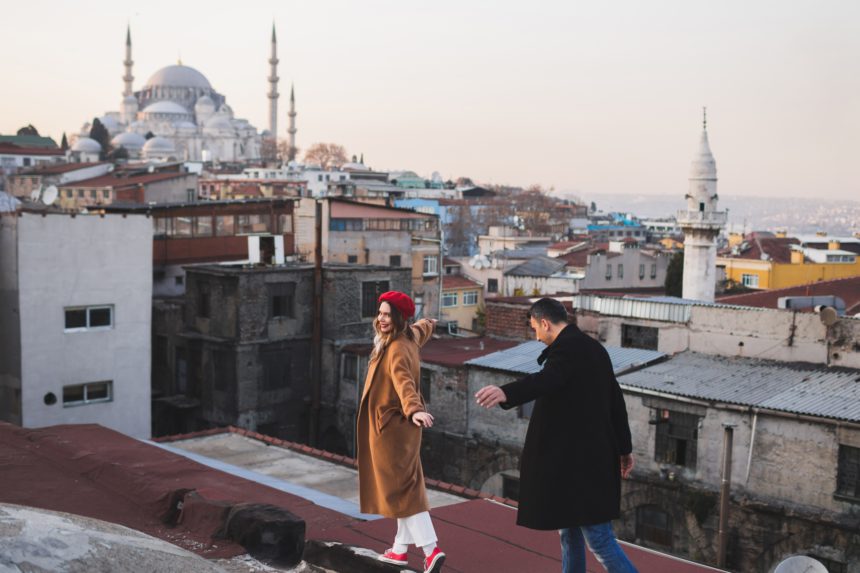Discover the Secrets of Istanbul: Strolling Through the Grand Bazaar and Visiting the Blue Mosque
Istanbul, a city that straddles two continents, is a vibrant tapestry of history, culture, and commerce. Among its many treasures, the Grand Bazaar and the Blue Mosque stand out as must-visit landmarks that encapsulate the essence of this magnificent city. This article will guide you through the secrets of these iconic sites, offering insights into their history, architecture, and cultural significance.
The Grand Bazaar: A Shopper’s Paradise
The Grand Bazaar, or Kapalıçarşı, is one of the largest and oldest covered markets in the world, boasting over 4,000 shops spread across 61 streets. Established in the 15th century, it has been a hub of trade and commerce for centuries, attracting millions of visitors each year.
A Historical Overview
The Grand Bazaar was built shortly after the Ottoman conquest of Constantinople in 1453. Initially, it served as a center for the trade of textiles and precious metals. Over the years, it evolved into a bustling marketplace where artisans and merchants from various backgrounds came together to sell their goods.
What to Expect
As you wander through the labyrinthine alleys of the Grand Bazaar, you will encounter a plethora of items, including:
- Handmade carpets and kilims
- Traditional Turkish ceramics
- Spices and herbs
- Jewelry and goldsmithing
- Leather goods and clothing
The vibrant colors, enticing aromas, and lively atmosphere create an unforgettable shopping experience. Don’t forget to haggle; bargaining is a cherished tradition in Turkish culture!
Insider Tips for Visiting
To make the most of your visit to the Grand Bazaar, consider the following tips:
- Visit early in the morning to avoid crowds.
- Take your time to explore the hidden corners and lesser-known shops.
- Try local delicacies from the food stalls.
- Be prepared to negotiate prices; it’s part of the experience!
The Blue Mosque: A Masterpiece of Ottoman Architecture
Just a short walk from the Grand Bazaar lies the stunning Blue Mosque, or Sultan Ahmed Mosque. Completed in 1616, it is one of the most important religious sites in Istanbul and a masterpiece of Ottoman architecture.
Architectural Marvel
The Blue Mosque is renowned for its striking blue tiles that adorn its interior, giving it its name. The mosque features a large central dome surrounded by smaller domes and six minarets, making it a unique sight on the Istanbul skyline. Its design was influenced by the Hagia Sophia, blending Byzantine and Islamic architectural elements.
Visiting the Mosque
Visitors to the Blue Mosque are often awed by its grandeur. Here are some key features to look out for:
- The intricate tile work that covers the walls and ceilings.
- The stunning stained glass windows that allow natural light to filter through.
- The spacious courtyard that provides a serene atmosphere for reflection.
As a functioning mosque, visitors are required to dress modestly. Women should cover their heads, and both men and women should wear clothing that covers their arms and legs.
Experiencing the Spiritual Atmosphere
Attending a prayer session can be a profound experience. The sound of the call to prayer, or adhan, resonates throughout the city, inviting worshippers to gather. The atmosphere inside the mosque during prayer is one of tranquility and reverence, offering a glimpse into the spiritual life of Istanbul.
Conclusion: A Journey Through Time
Exploring the Grand Bazaar and the Blue Mosque provides a unique opportunity to immerse yourself in the rich history and culture of Istanbul. From the bustling market stalls filled with treasures to the serene beauty of the mosque, these sites offer a glimpse into the heart of this enchanting city.
Whether you’re a history buff, a shopping enthusiast, or simply seeking to experience the local culture, Istanbul’s Grand Bazaar and Blue Mosque are not to be missed. They are not just tourist attractions; they are living monuments that tell the story of a city that has been a crossroads of civilizations for centuries.
